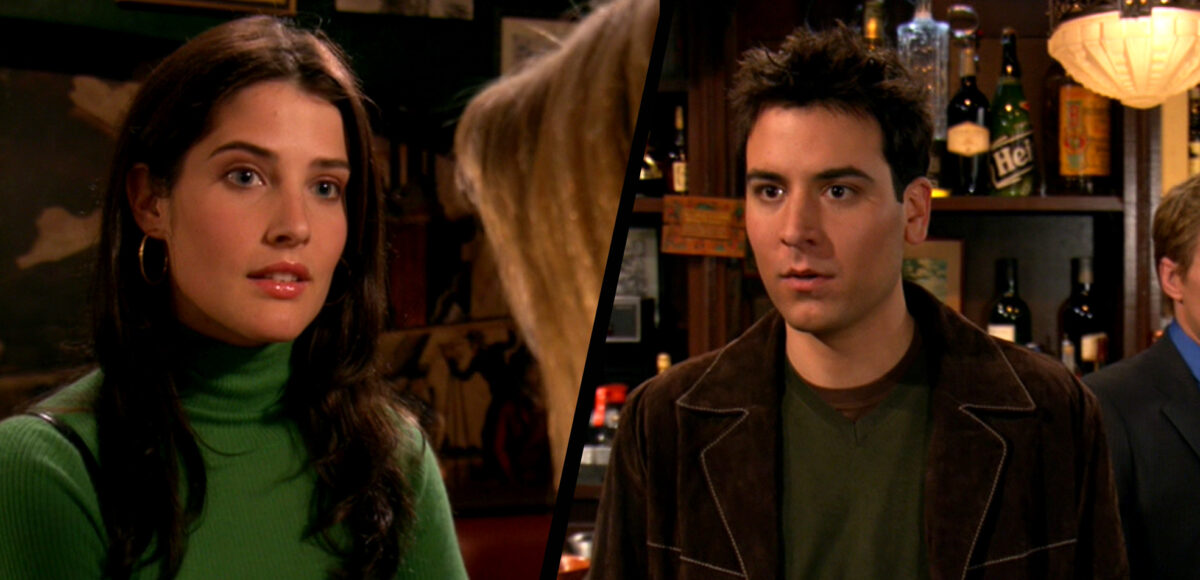As How I Met Your Mother’s Ted Mosby looks across MacLauren’s Pub, he sees Robin Scherbatsky, immediately smitten. This interest—coined “love at first sight” (LAFS)—is characterized by excitement and exhilaration towards an attractive other (though found not to be an actual experience of love8). Robin’s gorgeous with a smile that lights up any room. Relationship research tells us, though, that our stated preferences and actual desires may not align as we think.4 Rather, we must enter socially diagnostic situations to evaluate our compatibility and continued interest.3 In initiating this relationship, research suggests Ted should present himself as responsive and caring (strategic self-presentation), while staying aloof enough to avoid a broken heart (self-protection).3
Ted’s friend Barney introduces Ted through a game he calls, “Have you met Ted?” to which Robin wittily responds, “let me guess, Ted?” This lighthearted comment not only breaks the ice of a first interaction, but serves as a form of affiliative humor which is associated with increased relationship satisfaction.2 Because Robin says her friend has been broken up with so tonight all men are “the enemy,” Ted offers to let Robin throw a drink in his face to show her solidarity to her friends; Robin readily accepts. This gesture, with relatively low costs—nothing some cocktail napkins couldn’t fix—helps Ted show his interest in Robin through support.3 Ted concludes by asking Robin on a date, which she also accepts.
During their date, Ted gets nervous and makes a phallic comment about a blue French horn displayed in the bistro; amused, Robin laughs. Luckily, like many women, Robin’s attracted to a good sense of humor, which is also associated with relationship satisfaction.2,6 So, Ted makes it through the date, but doesn’t kiss Robin goodnight. He later gets mocked by his friends for this (but also garners support for the potential relationship, which bodes well as social support is associated with positive relationship outcomes7).
Ted later returns to Robin’s (having stolen the blue French horn as a “grand romantic gesture”), only to freak her out, confessing, “I think I’m in love with you.” While this sentiment could surprise anyone, it particularly shocks Robin, who (we later see) shows distinct signs of avoidant attachment: fearing commitment, finding it difficult to be intimate with others, etc.5 Ted departs, but not without professing that someday, he would make a great husband and father, providing a glimpse into their differing relationship ideals. This is a downside to LAFS: knowing less about a potential partner from shorter time romantic pre-relationship, including often having more personality trait differences.1
Though Ted doesn’t know it yet, all hope is not lost. He’ll go on to use other techniques, such as inviting Robin to communal activities and sacrificing his wants for hers, to grow their relationship, culminating in the initiation phase’s natural conclusion once they’ve “let down their guards” to one another.3
While we can’t definitively know characters’ thinking, relationship research provides a unique lens to watch Ted’s and Robin’s relationship unfold, kicking off this well-loved sitcom.
- Barelds, D. P. H., & Barelds-Dijkstra, P. (2007). Love at first sight or friends first? Ties among partner personality trait similarity, relationship onset, relationship quality, and love. Journal of Social and Personal Relationships, 24(4), 479–496. https://doi.org/10.1177/0265407507079235
- Caird, S. & Martin, R. (2014). Relationship-focused humor styles and relationship satisfaction in dating couples: A repeated-measures design. HUMOR, 27(2), 227-247. https://doi.org/10.1515/humor-2014-0015
- Clark, M. S., Beck, L. A., & Aragón, O. R. (2019). Relationship initiation: Bridging the gap between initial attraction and well-functioning communal relationships. In B. H. Fiese, M. Celano, K. Deater-Deckard, E. N. Jouriles, & M. A. Whisman (Eds.), APA handbook of contemporary family psychology: Foundations, methods, and contemporary issues across the lifespan., Vol. 1. (pp. 409– 425). Washington, DC: American Psychological Association.
- Eastwick, P. W. & Finkel, E. J. (2008). Sex differences in mate preferences revisited: Do people know what they initially desire in a romantic partner? Journal of Personality and Social Psychology, 94, 245-264.
- Edelstein, R. S. (2011). Chapter 3: Intimacy and Attachment. In The science of relationships: Answers to your questions about dating, marriage, and family (pp. 41–66). Kendall Hunt Publishing Co.
- Griskevicius, V., Haselton, M. G., & Ackerman, J. M. (2015). Chapter 1: Evolution and Close Relationships. In APA handbook of personality and social psychology (Vol. 3, Ser. Interpersonal relations, pp. 3–32). American Psychological Association.
- Sinclair, H. C., Hood, K. B., & Wright, B. L. (2014). Revisiting the Romeo and Juliet effect (Driscoll, Davis, & Lipetz, 1972): Reexamining the links between social network opinions and romantic relationship outcomes. Social Psychology, 45(3), 170–178. https://doi.org/10.1027/1864-9335/a000181
- Zsok, F., Haucke, M., De Wit, C. Y., & Barelds, D. P. H. (2017). What kind of love is love at first sight? An empirical investigation. Personal Relationships, 24(4), 869–885. https://doi.org/10.1111/pere.12218


As I big “How I Met Your Mother” fan, I really appreciate this blog post. Relating the readings to a popular television show brings important concepts to light and allows a visualization of the topics. It was particularly interesting that you noted Robin’s attachment style as avoidant, especially in the opening scenes of the show. I think that Robin is a perfect example of the concept that “people tend to become less avoidant and anxious with age and when they’re in satisfying relationships,” as her attachment becomes less avoidant once she develops satisfying relationships later on in the series.
I love how you walk the reader through each step of this relationship initiation process, explaining the psychological underpinnings along the way! As you state at the beginning, it’s wise to be somewhat aloof as a self-protective measure. The fact that you made this point, only for Ted to say “I love you” two paragraphs later made me laugh. The Clark article talks about how a potential partner’s attributes plays a role in relationship initiation. That supports the idea that Ted put himself out there so boldly because even after such a short amount of time, he could already tell that he liked her a lot, which is really silly and cute to think about.